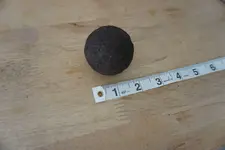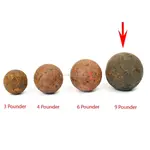You are using an out of date browser. It may not display this or other websites correctly.
You should upgrade or use an alternative browser.
You should upgrade or use an alternative browser.
Metal Ball
- Thread starter ANoble
- Start date
-
- Tags
- cannon ball
- Joined
- Aug 19, 2014
- Messages
- 39,006
- Reaction score
- 143,665
- Golden Thread
- 0
- Location
- Tarpon Springs
- Detector(s) used
- JW 8X-ML X2-VP 585
- Primary Interest:
- All Treasure Hunting
Looks like a 1 pounder to me.
Not being funny... Diameter should be 1.95
Not being funny... Diameter should be 1.95
Upvote
1
- Joined
- Aug 19, 2014
- Messages
- 39,006
- Reaction score
- 143,665
- Golden Thread
- 0
- Location
- Tarpon Springs
- Detector(s) used
- JW 8X-ML X2-VP 585
- Primary Interest:
- All Treasure Hunting
The term "one pounder" is the actual "name"... but more so the "caliber designation"... to be exact.
Upvote
0
coinman123
Silver Member
It looks like a one pounder, I hope it is! If so, you have a very nice relic on your hands! What is the diameter, it looks like it could be 1.95 inches like AARC said, I think you may have one.
Upvote
0
coinman123
Silver Member
Upvote
0
TheCannonballGuy
Gold Member
- Joined
- Feb 24, 2006
- Messages
- 6,606
- Reaction score
- 13,450
- Golden Thread
- 0
- Location
- Occupied CSA (Richmond VA)
- Detector(s) used
- White's 6000, Nautilus DMC-1, Minelab
- Primary Interest:
- Relic Hunting
"Precision" weighing, and diameter measuring, are crucially important for correctly distinguishing an actual cannonball from the many lookalikes which are NOT artillery balls. You say this ball weighs "exactly one pound, which causes me to assume you weighed it on a precision scale which said 1 pound 0 ounces. If that is the case, its precise weight and diameter of 1.95-inches (not counting the rust-encrustation) would indicate it is a 1-Pounder caliber cannonball, from the Colonial Era into the early-1800s. Its weight and diameter also indicate it is made of cast-iron, and not steel, which is a heavier alloy. (A steel ball of 1.95-inch diameter would weigh about 1 pound 1.6 ounces.) There were no steel Field Artillery cannonballs, so your ball being made of cast-iron keeps it in the cannonball category.
I checked the historical data on diameters-&-weight of Grapeshot and Canister-ammo balls used in America, and can tell you that your ball's diameter and weight don't match up with any Grapeshot or Canister balls.
I checked the historical data on diameters-&-weight of Grapeshot and Canister-ammo balls used in America, and can tell you that your ball's diameter and weight don't match up with any Grapeshot or Canister balls.
Upvote
0
Old Pueblo
Bronze Member
There was never much fighting with cannon in California history, back then. I find rusty metal balls like this at old mine sites or along railroad spurs that come out of the mines. It could also be a large ball bearing.
Upvote
0
TheCannonballGuy
Gold Member
- Joined
- Feb 24, 2006
- Messages
- 6,606
- Reaction score
- 13,450
- Golden Thread
- 0
- Location
- Occupied CSA (Richmond VA)
- Detector(s) used
- White's 6000, Nautilus DMC-1, Minelab
- Primary Interest:
- Relic Hunting
Just being Educational here... we can rule out a ball-bearing, because ANoble's ball is made of simple cast-iron. ALMOST ever since their beginning, ball-bearings have been made of steel, because of the crucial need for maximum durability/resistance-to-wear. Cast-iron doesn't stand up to "constant wear" very well at all.
Upvote
0
ANoble
Tenderfoot
- Joined
- Jul 28, 2017
- Messages
- 5
- Reaction score
- 16
- Golden Thread
- 0
- Primary Interest:
- All Treasure Hunting
- #14
Thread Owner
Wow thank you so much for the insight! Yes, I did weight it on a precision scale and it is exactly 1 pound. I don't have a way to get an exact diameter, but it is just shy of 2 inches from what I can tell.
Upvote
0
coinman123
Silver Member
It could be an early Spanish one pounder from Spanish occupation back in the 1700's.
Upvote
0
Similar threads
- Replies
- 8
- Views
- 521
- Replies
- 4
- Views
- 699
- Replies
- 2
- Views
- 372
Users who are viewing this thread
Total: 1 (members: 0, guests: 1)





